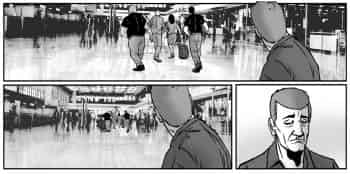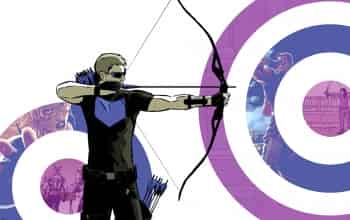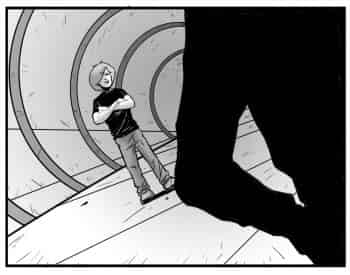
Writing
Confusion as a human characteristic
John Ostender started a discussion about the possibility of someone developing an algorithm to write stories. His reflections include this gem:
“My problem with the whole “computer as a creative writer” concept is that, while it’s an interesting exercise, there will be something essential lacking in its attempt to tell stories. We use stories to distill the human experience and computers lack that. […] As humans, we are all storytellers and we use story every day to explain life to ourselves and others. Computers simply don’t have that and I don’t think you can program them to compensate.” (“WriterBot 3000,” http://www.comicmix.com, March 22, 2015).
And you could say that behaving irrationally is a human characteristic. In Perfidia, James Ellroy’s last novel, all the characters struggle with their inner contradictions: they devise plans, adopt positions they can’t possibly hold in the face of external events, simply because they are in survival mode. These contradictions are all the more apparent because the story takes place over a few weeks only. Ellroy fans are used to longer time frames, when these twists can be interpreted as the characters’ psychological evolution.
In our own way, we’ve tried to apply this idea of inner contradictions to our story titled “Going All Out.” Valasquez, who normally manipulates events, is seen constantly improvising, taking risks that could put him in an uncomfortable position. His lack of control seems to lead him to take even more risks, like he’s challenging fate. He gives Benson an explanation, but we didn’t let the analysis get too deep because we wanted to leave a very human lack of logic in there. We even sought to apply another piece of advice from Ostrander: “Character is found in contradiction. Never try to explain a contradiction away; put it out there for the reader to explain it.”(“John Ostrander’s Writing Class: Details Details Details,” http://www.comicmix.com, April 5, 2015).
Expansion-compression
In the Apatrides universe, 1995 is a milestone year. Initially, it marked a change in the leadership of the Consortium and an ensuing change in their attitude to Black Orchestra’s assaults on them. But in the end, the repercussions of that change went much further. Blascovitch dies, Gypsie attacks the Black Orchestra, Votan/Travis is defeated and Benson is replaced. Though we usually pace our stories over months, for the year 1995, a whole cascade of events happened in only a few weeks. As we’ve said before, many of these events were planned. However, others were added as a result of certain other developments (the Travis-Gypsie saga).
Have a plan, but leave room to manoeuvre
In a long essay, Javier Grill–Marxauch looks back at his experience as a writer for the TV series Lost (“The Lost Will and Testament of Javier Grill–Marxauch,” http://okbjgm.weebly.com/lost, 24 March, 2015). The essay contains so many interesting blurbs about ups and downs of the creative process that we wanted to share a few:
“[…] we were paving the way for the good ideas by coming up with a lot of bad ones. Very bad ones.”
“[…] inspiration is always augmented through improvisation, collaboration, serendipity, and plain, old, unglamorous Hard Work.”
“[…] in television there is only one way of doing that: have great characters who are interesting to watch as they solve problems onscreen.”
“What I just described was only one of a continuum of very interesting, ongoing, moments in which improvisation—coupled with a strong conceptual foundation of previously generated ideas—provided crucial watershed events for the series.”
This long piece is packed with insights that can’t all be applied to our experiences on this comic, if only because the collaborative aspect is much more restricted here. So there is something for everyone to pick and choose from among his ideas.
But the idea of having a long-term plan and, at the same time, leaving room for short-term improvisation is something we apply in all our story lines. Here are a few examples:
Blascovitch was supposed to die much later on in the series, but we found this new timing quite appropriate. He’d made his major contributions, and his death opened the door for changes in the dynamics between Valasquez, Markham and Wood.
In the story “Going All Out—Part II,” Valasquez was supposed to let Gypsie go after torturing her. We decided to have her escape instead, as it was a good demonstration of her strength of character.
Votan—or at least Travis—was also supposed to die much later on in the story arc, but here again, the details were fuzzy. By getting rid of him earlier—and mainly via Cesar, who was egged on by his wife—we opened the story up to new interrelationships, whose potential we can sense even if we don’t yet have a clear picture of all the coming ramifications.
Women in control—Part IV
We like Gypsie because this character is not a prude and she uses her sexuality to get what she wants. She is talented at mental manipulation, but is more likely to use her body than her psychic abilities to achieve her goals. In that sense, her relationship with Travis was much more ambiguous than the one with Blascovitch. With the latter, sex was only a way for Gypsie to get favours. It was different with Travis. And while his death was predictable, it was still a shock for her.
Their ambiguous relationship may seem confusing. It’s Gypsie who dominates the couple, even though Travis (via Votan) is clearly more powerful. She gives Travis the ambition he seems to lack. There is of course an element of Lady Macbeth dormant in her. And Travis is simply stupid with love for her. He would do anything for her. Gypsie knows this and uses it to her advantage. But beyond the power that Votan confers onto Travis, and thus onto Gypsie herself, she is genuinely attached to Travis.
Death isn’t the only way for characters to leave the story
Death is inevitable in a story world like the one inhabited by the Apatrides. It would be unnatural if it weren’t. However, deaths shouldn’t become commonplace. In our opinion, Eva’s departure from the story is an elegant exit, one that opens up a new chapter of her life. Her departure does not mean she ceases to exist.
Characters live through their choices
John Ostrander discusses the issue of writing stories, and posits what he calls Newton’s First Law of Plot. Here’s a long quote from this great piece.
“What is important is not what the character says (or anybody else says about them); it’s what they do. It’s what they choose to do. Their choices define them. […] How do we determine what a given character will do in any given situation? It depends on their motivation. It’s not simply what they want; it’s what they need. It’s not just what they desire; it‘s what they lust for. […] We want something that will drive a character to action and that’s not always easy. Newton’s First Law of Motion states that a body at rest will remain at rest unless an outside force acts upon it, and a body in motion at a constant velocity will remain in motion in a straight line unless acted upon by an outside force. That’s true in a narrative as well. Maybe we’ll call it Newton’s first law of plot.” (“John Ostrander’s Writing Class: Newton’s First Law of Plot,” http://www.comicmix.com, March 29, 2015).
This brings us to an observation made by Darren about James Bond: “Ian Fleming originally constructed James Bond as a one-dimensional cypher, not too far removed from the original version of Sherlock Holmes who appeared in the works of Sir Arthur Conan Doyle. Characterisation was often inferred by the reader rather than explicitly articulated by the writer. A lot of what made Sean Connery or Roger Moore’s take on the character so fascinating existing as subtext rather than text.” (“Non-Review Review: Spectre,” https://them0vieblog.com, October 24, 2015). So, while Ian Flemming made his hero into a blank slate, his novels were still successful. This can be justified by Ostrander’s idea of motion, mentioned earlier.
One could argue that this option is valid only in action stories, but we see another facet of the idea of choice, which we’ve already mentioned: consequences. For instance, take a look at Vikram Murthi’s analysis of Don Draper: “[Don Draper]’s neither a murderer nor a psychopath, but he also doesn’t share the same motivations and desires with other antiheroes. He’s not on a quest for power or dominance, he doesn’t strive to destroy his enemies, and most importantly, he’s not beyond redemption. While Tony [Soprano] was the devil who lived next door and Walter [White] was the criminal mastermind disguised as your science teacher, Don is a socially sanctioned confidence man hiding his broken interior with a suit. He doesn’t exist on a good-bad continuum. He’s simply a man who wears many masks. […]Mad Men is one of the all-time great shows about self-destructive behavior and the toxic cycles someone falls into when they believe they don’t deserve anything better.” (“Don Draper is No Antihero,” http://www.avclub.com, March 30, 2015). Don is continually making choices—often bad ones—and a fair share of the TV series is built around his ability, or not, to come to terms with them. Therefore, the motion that Ostrander is talking about doesn’t necessarily only apply to superhuman actions.
Hawkeye by Matt Fraction and David Aja
Andrew Wheeler shines a light on how the Hawkeye series, developed by Matt Fraction and David Aja, has an almost one-of-a-kind positioning: “Fraction paced and framed his story as the everyday adventures of a blue collar man.” (“‘Black Widow’ #1 and the Hawkeyzation of Marvel Solo Titles”, http://comicsalliance.com, January 10, 2014). Kat Ward agrees with this view, stating that the series “examined what the Avenger got up to when he was off world-saving duty.” (“Meet Matt Fraction and Kelly Sue DeConnick, The First Couple of Comics,” http://www.ew.com, 14 January, 2015). What’s interesting in this series is how the scale of conflict is much smaller: for instance, saving a single building from the avarice of real-estate developers. The bad guys often don’t have superpowers. This universe is peopled with ordinary folks and their everyday problems. Fraction resisted the temptation to raise the stakes by creating outsized issues. And despite the commonplace events, the story remains rich, dense with complex relationships. It’s a dazzling and it’s daring.
Women in control —Part III
We continue our thoughts on the definition of a strong female character. In fact the word “strong” is not entirely appropriate: strength must fit into the character’s balance of strengths and weaknesses. Josef Siroka offers a similar analysis for films: “So, feminists shouldn’t have said, ‘We want more strong female characters.’ They should have said, ‘We want weaker female characters.’ Not weak in the ‘damsel in distress’ sense of the word, but weak as in having flaws (“Redéfinir le « personnage féminin fort» », http://blogues.lapresse.ca/moncinema/siroka, Feburary 11, 2014).
On a side note, the opposite of a strong woman character is one reduced to being only a damsel in distress. When we look at the Captain America film trilogy, we see that at no point do the women need saving by the superhero.
Back to the Apatrides universe, it’s Jenny who tells Markham she wants to go to a Black Orchestra training camp. At that point, she is the only character in the stories already posted, to volunteer for the camps and be fully aware of what she’s requesting.
Going beyond duality: The experience of Lost
Columnist Davin Faraci gave his analysis of comments made by Javier Grill–Marxauch about his writing for the TV series Lost. Faraci ends on this note: “Unfortunately the ways the show dealt with these topics—like the Manichean battle between good and evil—simply weren’t up to the level of what was happening in seasons one through three.”(“Walt Was Psychic: An Amazing Look at the True Development of LOST,” http://birthmoviesdeath.com, March 24, 2015). In our view, this is partly accurate, but the series’ greatest shortcoming was in the psychological development of the Man in Black. One episode uses flashbacks to try to show his motivations and his relationship with Jacob and his mother. It shows a man who really wants to leave the island, but whose dreams are crushed by his mother. Because of this, he kills her, and his brother seeks to destroy him. From a man who craves freedom, he evolves into a creature of destruction with only a single motivation. But his origin story showed a more nuanced person. And his brother, Jacob, wasn’t a compassionate character. In short, the series, rather than developing a more nuanced relationship between the two, adopted a classic Manichean duality, where the viewer cannot feel any compassion for one party. This was a missed opportunity for a much richer ending to this TV series that had otherwise taken so many risks during its run.














